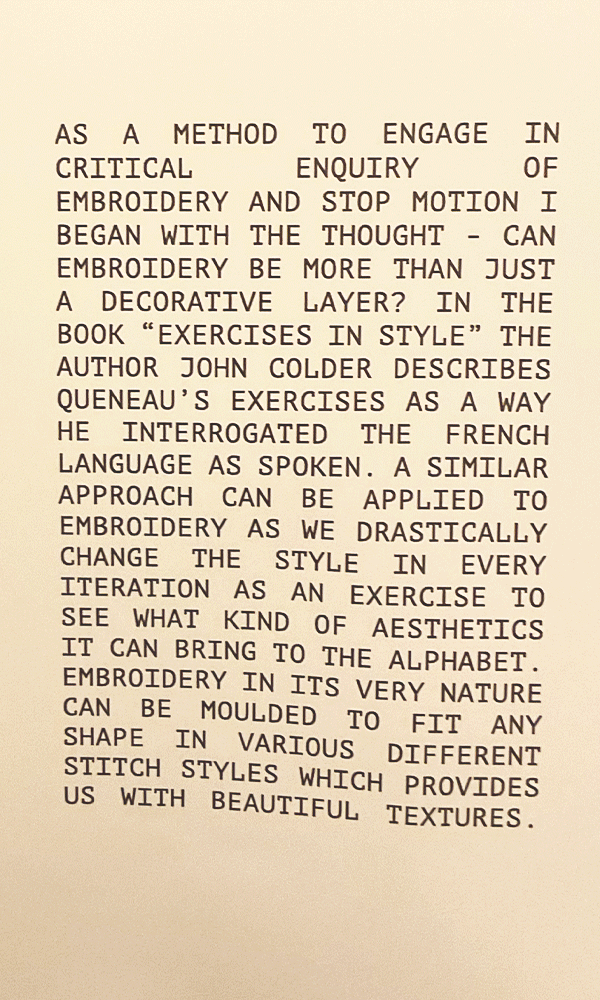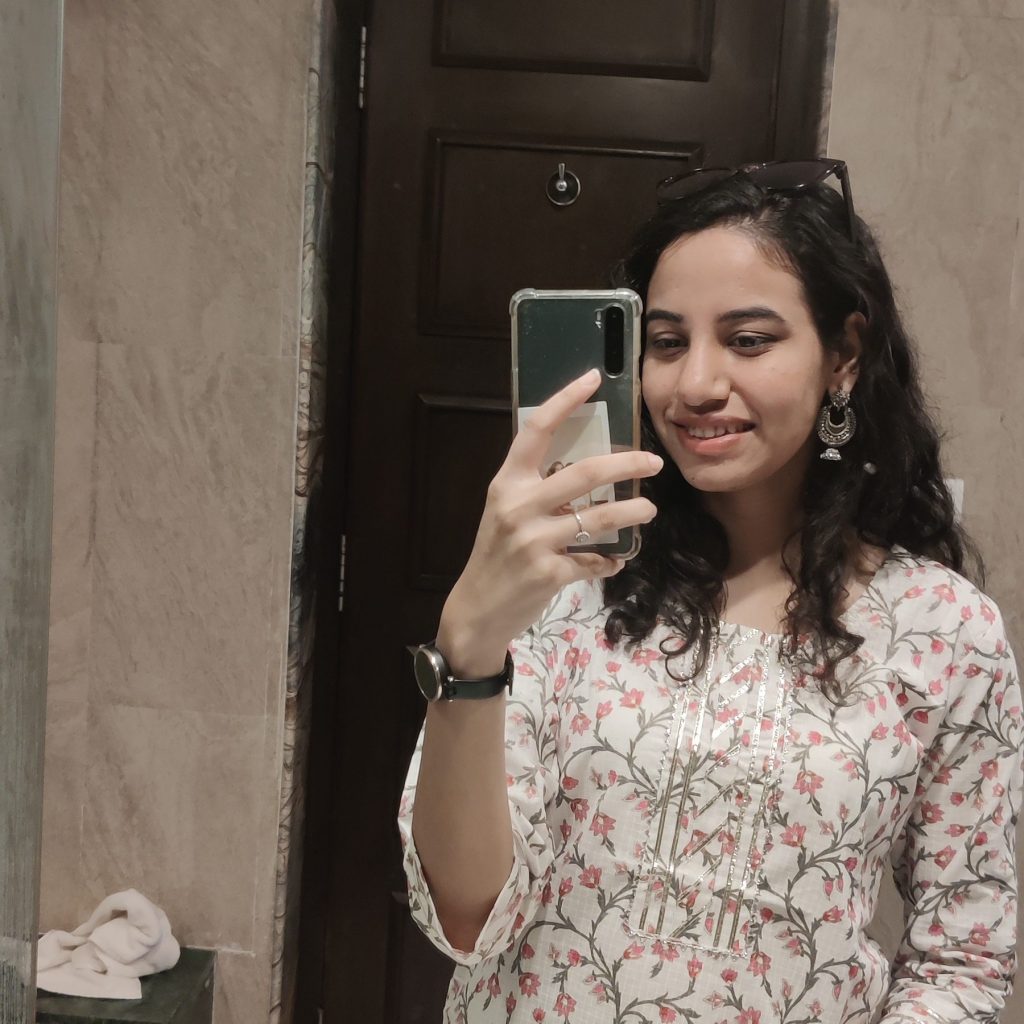Written response – Methods of iterating
Macro and micro Iterations
I realized that our minds constantly perform two types of iterations: micro and macro. Micro iterations happen in the moment, like adjusting the needle’s position with tiny movements until it pokes through the perfect spot. Macro iterations are broader, like experimenting with different ways to achieve a fabric color—buying a matching shade, photoshopping it, or, as I discovered while cleaning my fridge, dyeing it pink with beetroot. While macro iterations feel more noticeable, micro iterations often go unseen but are equally impactful. Over time, these invisible adjustments saved me significant effort, reducing the time to create each cat artwork by up to 80%.
Did it pose a particular technical challenge?
- Drawing accurately on cloth. How do people sketch complicated geometric drawings on cloth?
- Translating a graphic idea into an embroidery-friendly design requires adapting to the medium’s constraints, such as limited resolution and the need for stitchable shapes.
- Embroidery is a fluid, continuous repetitive process that only comes through a state of flow. The stitches come through intuition after practicing it for a few times. To copy a given piece of embroidery goes against that. And the precision required for a frame by frame animation also was a challenge.
- Very little room for error. I understood the true meaning of the proverb “A stitch in time saves nine”.
What kind of output or knowledge does this tool or medium favor?
- Textural depth and detail: The physical presence of thread creates a sense of dimension that digital media can’t replicate.
- Decoration as the purpose: Most commonly found on fabrics as embellishments.
- Slow and deliberate creation: Unlike digital tools that allow rapid iteration, embroidery demands time and precision.
- Organic or human qualities: Imperfections in stitching highlight the hand of the creator, making the work feel personal and unique.
- Tradition and Femininity: Embroidery is often associated with domesticity, femininity, or traditional art forms.
Assumptions about skills or knowledge.
- Some familiarity with needlework techniques, like stitching patterns, tension control, and thread selection.
- Embroidery’s physical limitations (e.g., detail scaling, time for stitching) and stop motion’s requirements for smooth frame transitions likely shaped your design choices.
Ideas for proposal.
How might we use embroidery to produce a non tactile output?
What other tools can we use the methods of embroidery on or with?
Embroidery serves as an embellishment /top layer on fabric as a communicative / decorative element, similar to graphics on packaging. Can we use embroidery to communicate more than just decorate?
Embroidery carries a tactile texture and an imperfect, organic quality. This could inspire the creation of a hand-lettering font that reflects its unique character.
Motion of a cat jumping was studied through embroidery – What if we study it through different mediums and see how each medium changes / affects the output and the form and motion study?
Embroidery signifies many things or is associated with – craft, time, serenity. Can we add anything more to this? Both embroidery and stop motion share an emphasis on meticulous, hands-on creation, reinforcing the storytelling potential of handcrafted work.
Draft 1
Proposal :
Embroidery often serves as a decorative layer, similar to certain graphics on packaging. This project aims to explore how embroidery can communicate meaning beyond embellishment. By integrating text, symbols, or data visualization into stitched designs, embroidery could become a medium for storytelling or conveying information. Examples might include embroidered infographics, stitched fonts, personal narratives stitched into clothing, or tactile signage for accessibility. This proposal seeks to redefine embroidery as a tool for meaningful communication, bridging the gap between art, craft, and information design.
Draft 2
As a method to engage in critical enquiry of embroidery and stop motion I began with the thought – Can embroidery be more than just a decorative layer? In the book “Exercises in style” the author John Colder describes Queneau’s exercises as a way he interrogated the French Language as spoken. A similar approach can be applied to embroidery as we drastically change the style in every iteration as an exercise to see what kind of aesthetics it can bring to the alphabet. Embroidery in its very nature can be moulded to fit any shape in various different stitch styles which provides us with beautiful textures.
The aim or focus of this enquiry will not be the polished fonts that are fully developed but using embroidery styles as a tool to view type design in a new way. There are many systems used in embroidery and type design that overlap. Examples of these are geometry, grids, multiple iterations while making, prototyping, etc. This project breaks away from the traditional use and context of embroidery as surface embellishment and also some of the more modern applications in branding that only extended to tote bags and logos rendered in embroidery.
To even deepen this inquiry this process can be used to interrogate many other handmade craft techniques that have long been boxed in a specific context. It is not necessary to make a font out of it as John says that “the language or story as such does not matter, it is an interrogation in communication patterns”.
References:
Quenuau, Raymond and John Colder. (1947 and 1998) Exercises in style. L
Draft 3
For the third draft, I translated the text into embroidery stop motion, where each word gradually converts into the simplest form of cross-stitch. This translation overlaps the printed words, making them illegible over time. The sequential nature of this transformation invites the reader to engage actively, reading the text before it becomes obscured by stitches.
This process creates a tension between language and image, where meaning slips away as visual interference increases. Stitched words demand both urgency and reflection. By changing the reading experience this way , the medium disrupts the passive consumption of text.
Embroidery as a medium offers a tactile and analog counterpoint to traditional text rendering. The stop-motion helps the stitches unfold visually. It is not about the content of the text but its erasure, which challenges notions of permanence in written language.
How does the text and its meaning change when you translate it in this way?


Leave a Reply